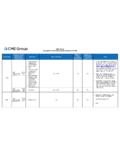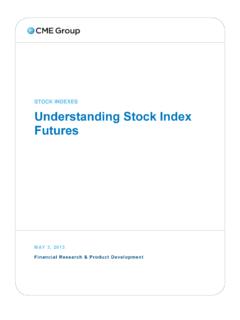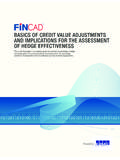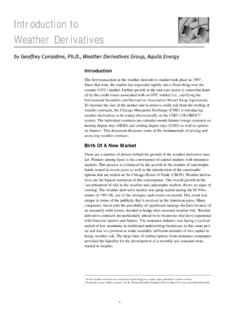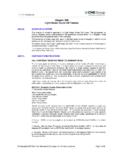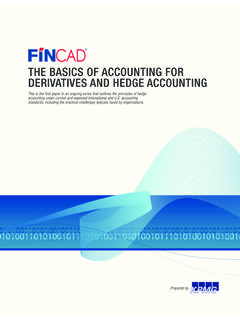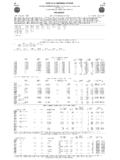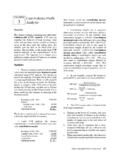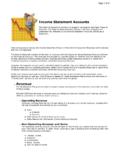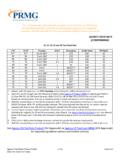Transcription of Risk Management for Fixed Income Asset Managers
1 INTEREST RATES Risk Management for Fixed Income Asset Managers John W. Labuszewski Michael Kamradt David Gibbs Managing Director Executive Director Director Research & Product Development 312-466-7469 Interest Rate Products 312-466-7473 Product Marketing 312-207-2591 2 | Risk Management for Fixed Income Asset Managers | CME GROUP Capital market volatility in recent years has introduced unprecedented challenges for Fixed Income Asset Managers . The subprime mortgage and credit crisis prompted the Federal Open Market Committee (FOMC) to push the target Fed Funds rate to the lowest level in history at Longer-term rates have generally declined as well as a result of the FOMC s Asset repurchase programs.
2 But recent indications of economic growth and a possible pull-back from these easy money policies have led many Managers seeking a hedge against possible rising rates and other market adjustments. Throughout this market turbulence, CME Group has provided risk- Management tools that serve to assist Fixed Income portfolio Managers in this challenging environment. This document is intended to serve as a primer regarding how one may utilize CME Group Fixed Income products to balance risks and seize opportunities as they arise. Four Critical Decisions Fixed Income Asset Managers face four critical decisions in their pursuit of investment value (or alpha ) while managing the attendant risks.
3 Specifically, they must determine how to address risk that may be defined along four key dimensions including (1) portfolio duration; (2) yield curve structure; (3) sector; and (4) security selection including credit risk and structural issues. 1. Portfolio Duration All Fixed Income portfolios are profoundly impacted by the simple advance or decline of interest rates. Duration represents the most efficient way of measuring portfolio risk subsumed into a single value. Specifically, duration represents the expected percentage change in the value of a portfolio given a general fluctuation in interest rates. , a portfolio with duration of 4 years is expected to experience a principal loss of 4% if rates increase by 100 basis points ( ).
4 Portfolio Managers generally target the appropriate interest rate sensitivity of the portfolio based on an analysis of investor s preferred performance benchmark or target, risk tolerance and interest rate trends. If yields are expected to decline, a longer-duration portfolio may be preferred; if yields are expected to advance, a shorter-duration portfolio may be recommended. 2. Yield Curve Structure It is possible to construct a portfolio of any particular average weighted duration in many different ways using securities positioned along the yield curve. , a portfolio with a duration of 4 years may be constructed exclusively of securities with durations of 4 years a bullet.
5 Alternatively, one may use a combination of shorter and longer duration securities a barbell - or simply purchase a range of securities along the yield curve - a ladder to achieve a portfolio duration of 4 years. While all three of these portfolio structures may exhibit similar sensitivity to a parallel shift in the yield curve, they may generate much different returns if the yield curve were to steepen, flatten or twist in shape. As a general rule, if the yield curve is expected to steepen, it is advantageous to maintain a bullet portfolio; if the yield curve is expected to flatten or invert, a barbell portfolio may be preferred. 3.
6 Sector Risk Fixed Income Managers may allocate their holdings across a rather broad spectrum of securities including Treasuries, agencies, corporates, municipals, mortgage backed securities (MBS), commercial mortgage backed securities (CMBS) and other Asset -backed securities (ABS). Each of these sectors offers their own unique characteristics, risks and yields. Astute Managers must decide how much of the portfolio s duration should be attributable to each sector. , if the average weighted portfolio duration equals 4 years, Treasuries with an average weighted duration of 4 years might be used to comprise 25% of the portfolio s composition. The remaining 75% of the portfolio might be allocated across other Fixed Income securities likewise with an average weighted duration of 4 years.
7 Credit events such as the subprime mortgage crisis exert an impact the relative value of Fixed Income securities in different sectors. Note, for example, that yield spreads between corporate and Treasury securities widened considerably as 3 | Risk Management for Fixed Income Asset Managers | CME GROUP investors opted for the relative safety of government securities during the crisis. Asset Managers frequently adopt a practice of rotating or re-allocating investment amongst these sectors by reference to the relative value or yield spreads of the different types of securities in response to credit conditions. 4. Security Selection Within each Fixed Income market sector, there are a wide variety of securities with different investment characteristics and structures.
8 , one might opt for a low or a high coupon security with similar durations. One might invest in investment grade (rated BBB- or Baa- or better by a rating agency) or high-yield corporate securities (rated BB+ or Ba+ or less). Some securities may be callable or offer other types of optionality. Other securities may be available with no frills of that sort. It s incumbent upon the Asset manager to select suitable individual securities to achieve the specific investment objectives and to remain bounded by the investment constraints of the ultimate investor. In the final analysis, and no matter how the Asset manager makes investment decisions, performance generally is judged by reference to a Fixed Income benchmark.
9 The Barclays Capital Aggregate Bond Index stands out as common reference in this regard. Of course, there are many candidate indexes which might similarly serve as a bogey. Thus, Asset Managers typically strive to make investment decisions relative to the benchmark on the four points as above in hopes of achieving enhanced returns, or beating the bogey. Many Managers find that the suite of interest rate products offered by CME Group are essential tools in an active, disciplined portfolio Management process which seeks to add alpha while relegating risk to acceptable levels. Let s discuss some practical examples of how CME Group interest rate products might be deployed to address risks relating to duration; the shape of the yield curve; sector; and, the security selection process.
10 Measuring Risk There is an old adage to the effect that you can t manage what you can t measure. In the Fixed Income security markets, one generally measures portfolio risk by reference to duration or its close cousin basis point value (BPV). Duration is a concept that was originated by the British actuary Frederick Macauley. Mathematically, it is a reference to the weighted average present value of all the cash flows associated with a Fixed Income security, including coupon Income as well as the receipt of the principal or face value upon maturity. , the most recently issued or on-the-run 10-year Treasury note as of January 11, 2012 was the 2% security maturing November 15, 2021.

